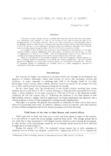Chemical Control of Rice Blast in Korea
Tropical agriculture research series : proceedings of a symposium on tropical agriculture researches
| ISSN | 03889386 |
|---|---|
| NII recode ID (NCID) | AA00870529 |

Full text
tars16-_113-123.pdf1.72 MB
Cultivation of high-yielding varieties including indica-japonica hybrids and improved production technology have resulted not only in the increase of rice yield potential but also in the changing pattern of rice blast incidence. One of the main constraints to achieving high yields is the damage caused by blast disease. Annual yield losses due to blast in Korea have been estimated at 8.4% for the last 5 years, assuming no chemical control was initiated. Normally, blast chemical control provides annual average increase of 6.3% or 0.27 metric ton per ha in yield. As acreages of blast incidence increased due to the breakdown of the resistance of new highyielding varieties, chemical applications have been greatly increased in the last decade, i.e. from 1.5 applications in 1970 to 3.3 in 1981. And the proportional increase of rice yield has also resulted in an average production of 4.3 metric tons per ha per year in the last 5 years.
There is a fair amount of information available on the use of fungicides effective against rice blast, including suitable formulations and methods and timing of application. However, farmers should use fungicides only when other methods, alone or in combination, are ineffective. The use of fungicides should be minimized and decided, based on a blast management approach in combination with other control methods.
There is a fair amount of information available on the use of fungicides effective against rice blast, including suitable formulations and methods and timing of application. However, farmers should use fungicides only when other methods, alone or in combination, are ineffective. The use of fungicides should be minimized and decided, based on a blast management approach in combination with other control methods.
| Date of issued | |
|---|---|
| Creator | Seung-Chan LEE |
| Publisher | Japan International Research Center for Agricultural Sciences |
| Volume | 16 |
| spage | 113 |
| epage | 123 |
| Language | eng |
